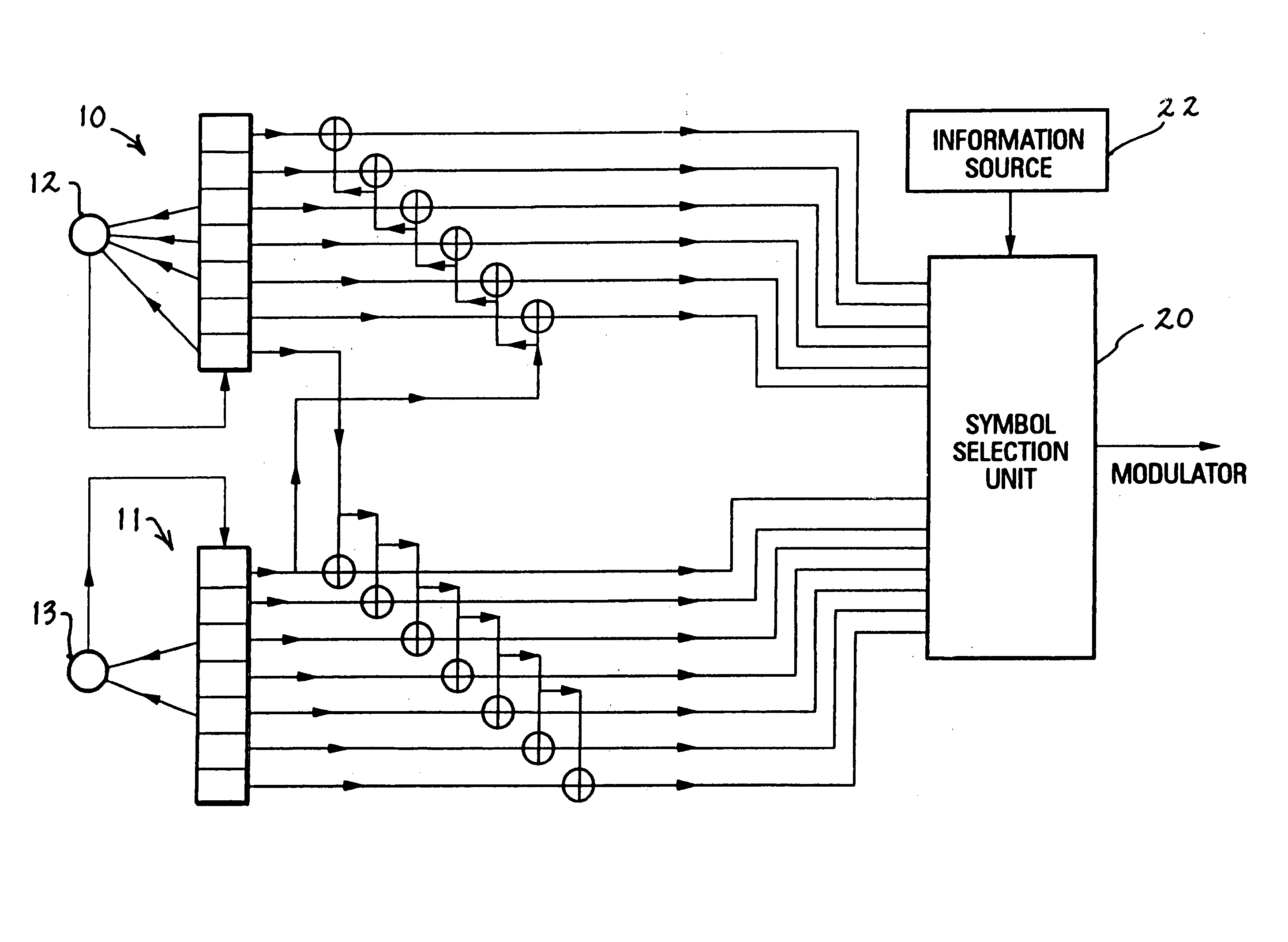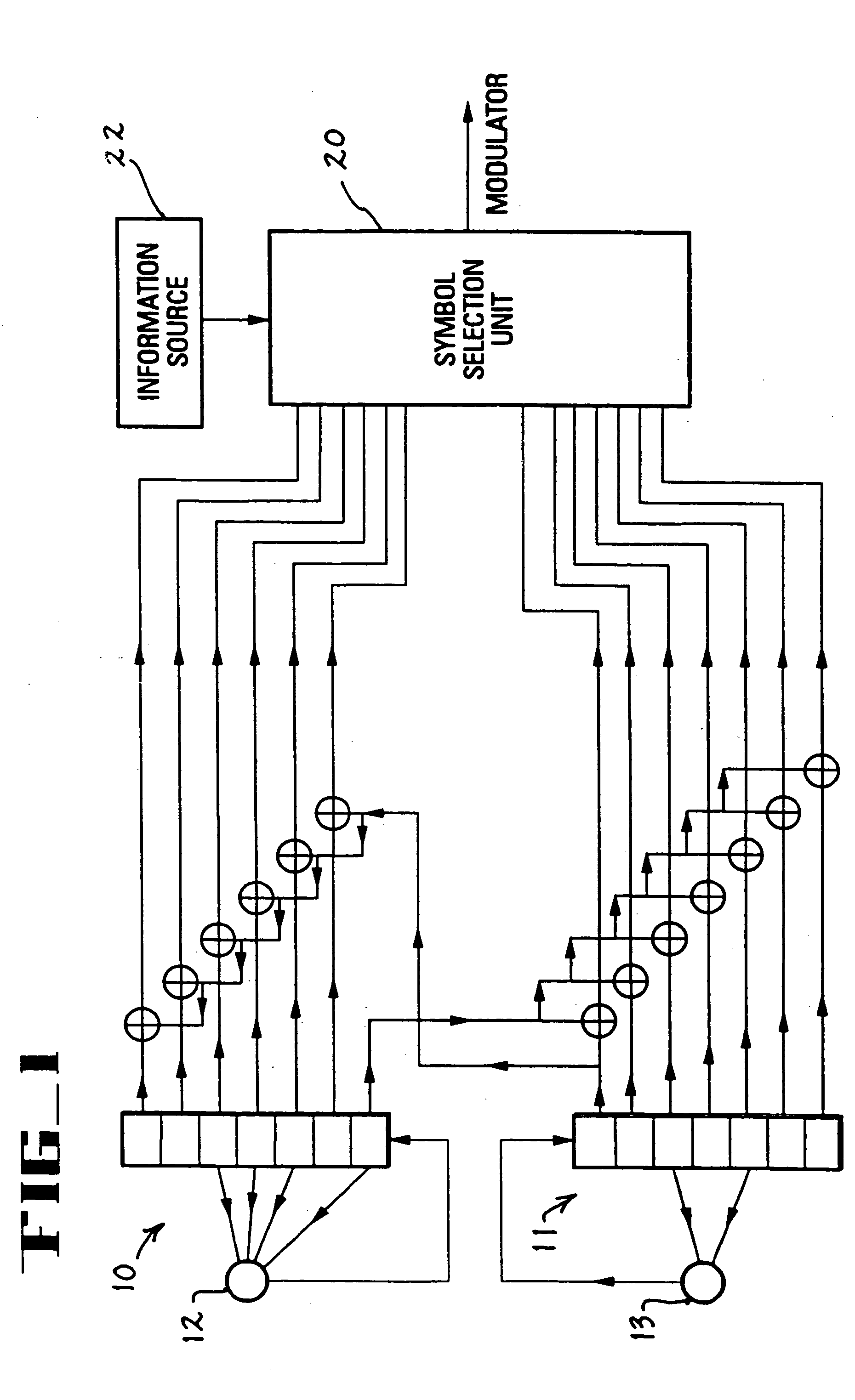Spread-spectrum transceiver
- Summary
- Abstract
- Description
- Claims
- Application Information
AI Technical Summary
Benefits of technology
Problems solved by technology
Method used
Image
Examples
embodiment i
In a particular embodiment of a multi-node digital communication network according to the present invention as illustrated in FIG. 1, a composite code sequence (e.g., a Gold code sequence, a symmetric sequence, a Kasami code sequence, or the like) is used as the spreading-code sequence, and one sequence at a time is transmitted. The number K of spreading-code sequences assigned to each node of the network is 2r, where r is a positive integer such that
1≦r≦[log2 (M1+M2−1)],
where [log2 (M1+M2−1)] denotes the “greatest integer” function, where M1 and M2 represent the numbers of stages in corresponding registers of the two-register spreading-code sequence generator. In the following discussion, it is assumed that M1=M2=M. Modification of the discussion to accommodate a situation in which the registers have different “lengths” (i.e., different numbers of stages) is straightforward.
A spread-spectrum digital communication system according to the present invention can be constructed for ...
embodiment ii
In an alternative embodiment of the present invention, as illustrated in FIG. 5, two spreading-code sequences are selected from among all the available spreading-code sequences generated by the shift registers 10 and 11 during each period of the sequences. The selected sequences are used to modulate the “in-phase” arm and / or the “quadrature” arm, (also called the I-arm and the Q-arm), respectively, of a sinusoidal carrier. Modulation of the I-arm and the Q-arm can be achieved using a quaternary phase-shift keyed (QPSK) modulation, an offset QPSK (also called an OQPSK) modulation, a quadrature partial response (QPR) modulation, or any other type of quadrature modulation. If K spreading-code sequences are available to each node of the network, there are K(K-1)2
possible pairs of spreading-code sequences that can be transmitted per symbol interval. Thus, by selecting two of the K available spreading-code sequences for transmission during each symbol interval, [log2K(K-1)2]
bits o...
embodiment iii
In a third embodiment of the present invention as illustrated in FIG. 6, two spreading-code sequences are selected during each symbol interval, viz., one “upper” sequence and one “lower” sequence from each of the shift registers 10 and 11. If the number of spreading-code sequences available to each node of the network is K=2r, each subset contains 2r−1 sequences, so that 2(r−1) bits of information can be transmitted per symbol interval. If the polarity of each spreading-code sequence is selectively inverted, or not, according to a differential coding scheme, then 2+[2(r−1)]=2r information bits per symbol interval are transmitted. For example, if K=8, then six information bits per symbol are transmitted.
Since symbol decisions are made within each subset of spreading-code sequences, there is no need to choose the “correct” subset in order to identify the “correct” spreading-code sequence. Thus, decision logic is considerably simplified. Also, symbol decisions are made between seque...
PUM
 Login to View More
Login to View More Abstract
Description
Claims
Application Information
 Login to View More
Login to View More - R&D
- Intellectual Property
- Life Sciences
- Materials
- Tech Scout
- Unparalleled Data Quality
- Higher Quality Content
- 60% Fewer Hallucinations
Browse by: Latest US Patents, China's latest patents, Technical Efficacy Thesaurus, Application Domain, Technology Topic, Popular Technical Reports.
© 2025 PatSnap. All rights reserved.Legal|Privacy policy|Modern Slavery Act Transparency Statement|Sitemap|About US| Contact US: help@patsnap.com



